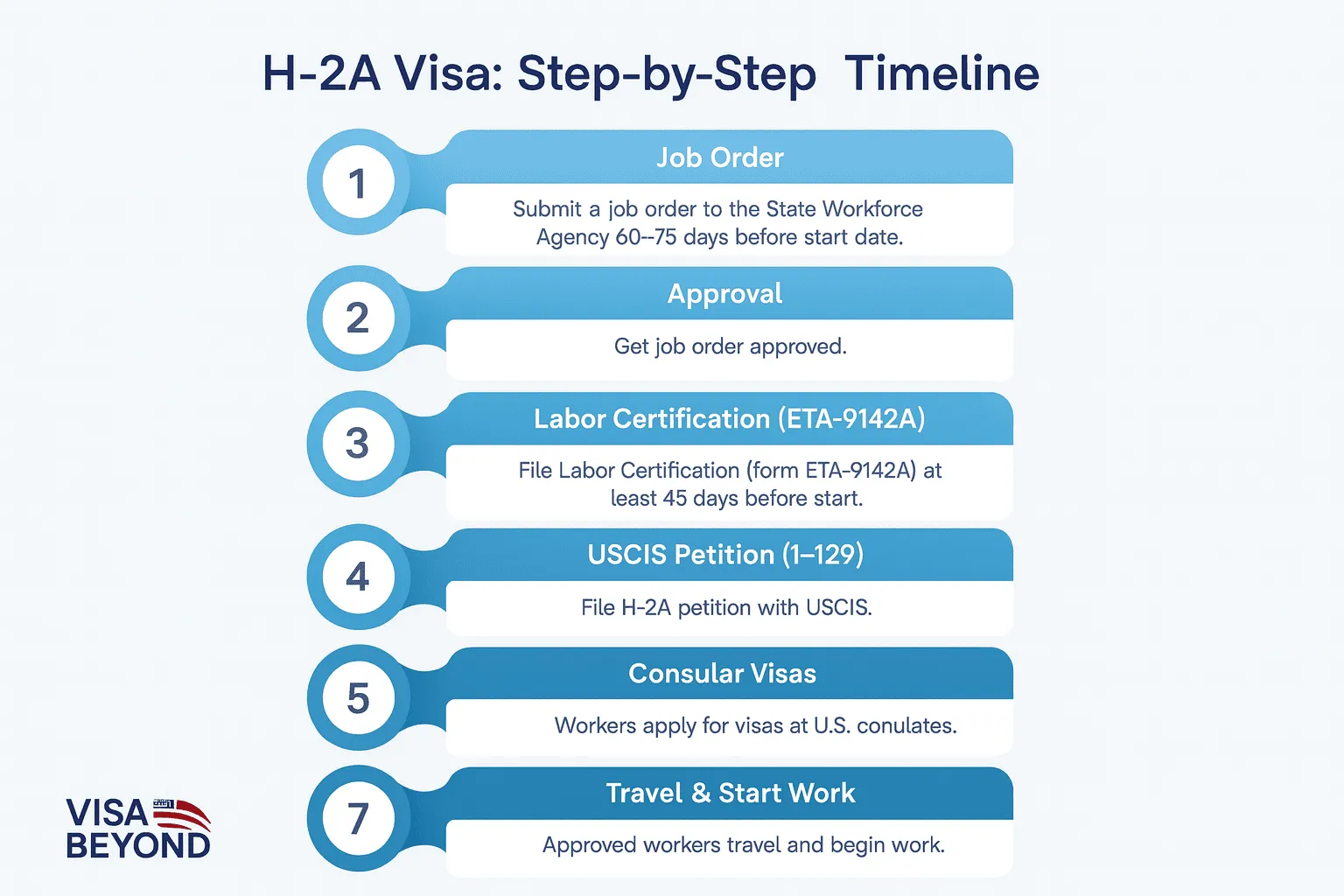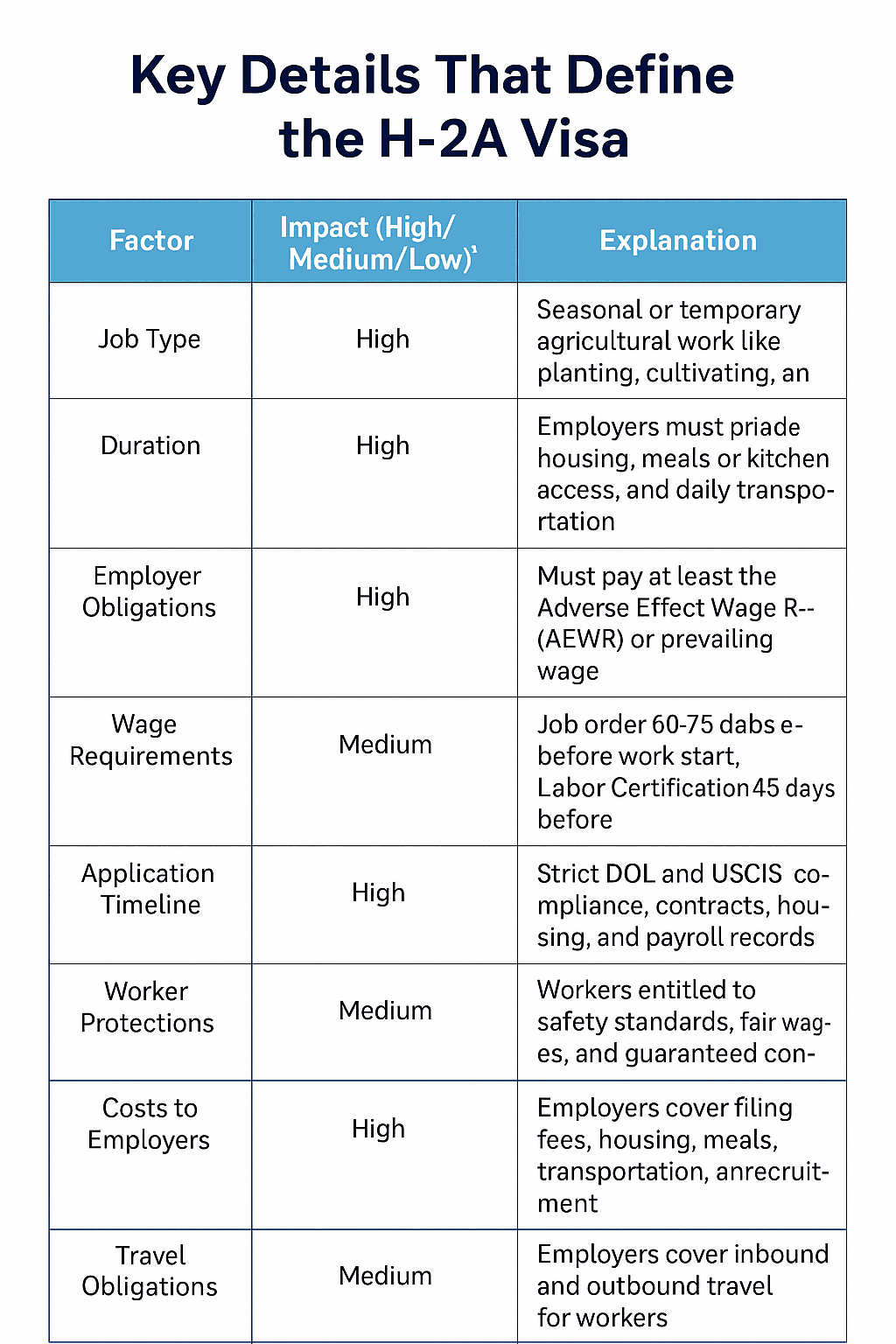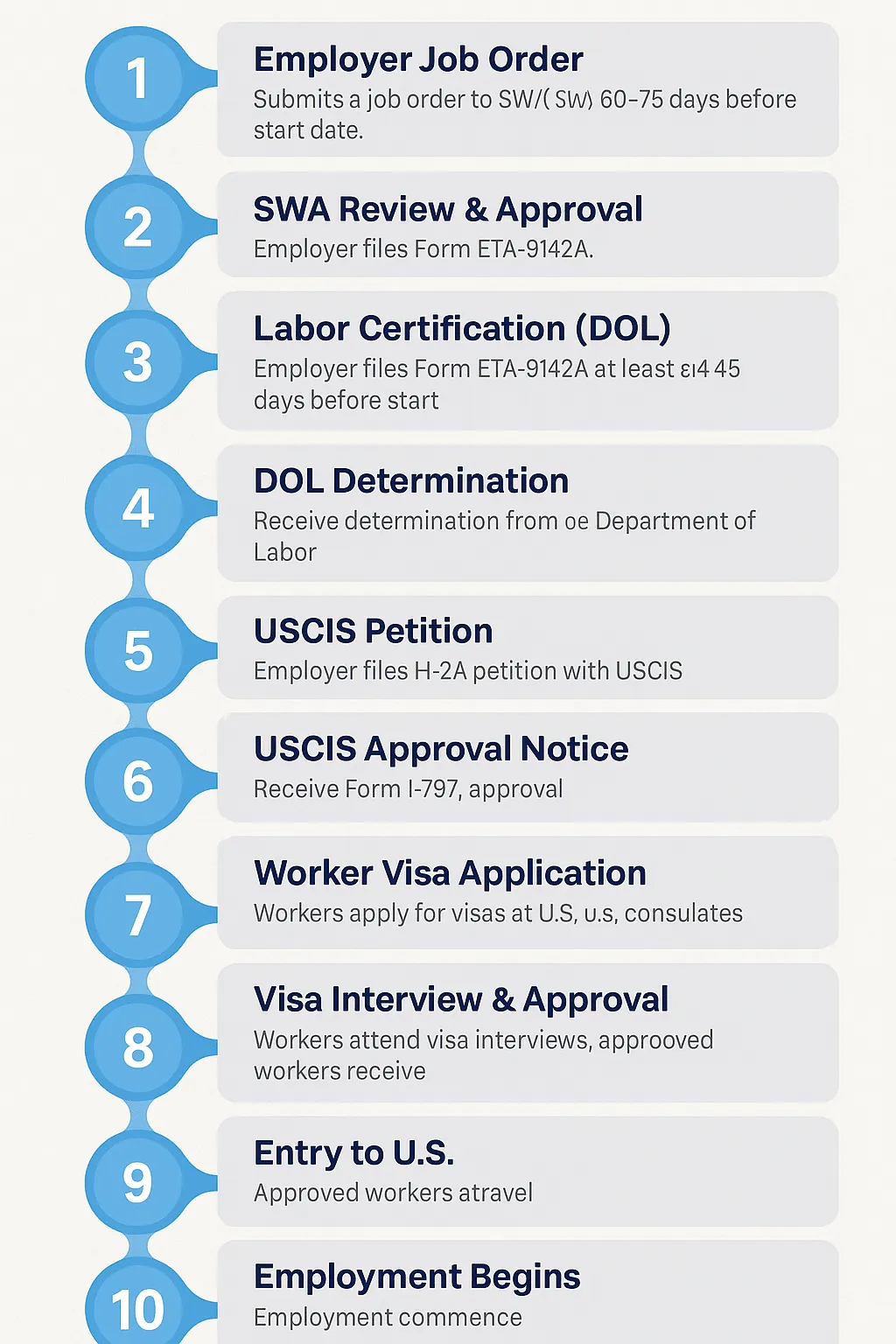H-2A Visa:
Program for Agricultural Employers
The H-2A visa program is a federal initiative that allows U.S. agricultural employers to hire foreign workers for temporary or seasonal jobs
From FY 2018 through FY 2023, approved H-2A jobs and visas increased by over 50 %
The H-2A visa program allows foreign workers to gain legal employment in the United States, especially in agriculture.
H-2A visas are temporary, but the program offers flexibility through dual intent
One of the biggest benefits of the H-2A visa is family inclusion.
The H-2A visa program guarantees a competitive wage through the Adverse Effect Wage Rate (AEWR),
The H-2A visa provides valuable career flexibility, enabling workers to gain practical experience
Client
Satisfaction
Years
in the business
What Is the H-2A Visa Program?
The H-2A visa program is a federal initiative that allows U.S. agricultural employers to hire foreign workers for temporary or seasonal jobs when there are not enough domestic workers available. It was created to ensure that farms and agricultural businesses can keep running smoothly during busy times of the year, such as planting, cultivating, and harvesting, when labor demand is at its highest.
Seasonal work refers to jobs tied to a specific time of year or crop cycle. Temporary employment generally lasts no more than one year. For example, an apple orchard may need additional workers only during the fall harvest season, while a vegetable farm may require help during planting and picking months. The H-2A program ensures these labor shortages do not threaten production or farm income.
Who Qualifies for the E-2 Visa?
To qualify for the E-2 Visa, applicants must meet several key criteria. They must be citizens of a treaty country and make a significant investment in a U.S. business. Additionally, they must own at least 50% of the enterprise or have operational control, and the business must be viable, generating enough income to support the investor and their family.
How Long Does It Take to Complete an E-2 Visa?
The E-2 Visa process generally takes between 2 to 4 months from application to approval, depending on the consulate or embassy handling your case. However, premium processing is available, reducing the waiting time to 15 days.
H-2A Visa Success Rate.
Of certified H-2A jobs, around 80 % result in actual visa issuance in recent years
the U.S. business
H-2A Visa Application Costs and Processing Timeline
Employers file Temporary Labor Certification (TLC) with the Department of Labor first (≈ 45 days before employment start date).Once certified, employers file Form I-129 with USCIS.
- No USCIS filing fee for H-2A petitions (unlike H-1B).
- Employers must cover costs of recruitment, job advertising, and compliance.
- Employers pay for transportation, housing, and meals (or provide allowances) for workers.
- Workers are not required to pay recruitment or processing fees under U.S. law.
- Step1: Job Order – Submit to State Workforce Agency (60–75 days before need).
- Step 2: Labor Certification – File with DOL after job order approval.
- Step 3: USCIS Petition – Employer files Form I-129 for workers
- Step 4: Consular Processing – Workers apply for visa at U.S. consulate abroad.
- Step 5: Entry & Employment – Workers enter U.S. and begin seasonal agricultural work.
FAQs
About H-2A Visa.
What is the main purpose of the H-2A visa?
To allow U.S. agricultural employers to hire temporary foreign workers when domestic labor is unavailable.
How long can an H-2A worker stay in the U.S.?
Up to one year, with possible short extensions.
Can an H-2A worker bring family members?
Yes, dependents may apply for H-4 visas, but they cannot work.
When should employers apply?
At least 60–75 days before the date workers are needed.
Do H-2A workers pay taxes?
They may owe federal income tax but are exempt from Social Security and Medicare.
Who pays for housing?
The employer must provide free housing that meets legal standards.
Is transportation covered?
Yes, employers must reimburse transportation costs after 50% of the contract.
Can H-2A workers switch employers?
Only if a new certified employer petitions for them.
What happens if fewer work hours are available?
The employer must still pay 75% of the contracted hours (the three-quarters guarantee).
How much does the program typically cost employers?
On average, $10,000–$12,000 per worker, including housing and travel.
Clients we
work for.
















H-2A Visa Everything You Need To Know
Running a farm or agricultural business today requires more than equipment and land—it requires people. For many U.S. farmers, finding enough reliable workers during peak planting, cultivating, or harvesting seasons is one of the toughest challenges. Crops cannot wait, and labor shortages can quickly lead to lost yields and reduced income. That’s where the H-2A visa program steps in as a lifeline for agricultural employers.
Key points of H2-A Visa
It covers planting, cultivating, harvesting, and other agricultural operations
Seasonal Work
Seasonal work under H-2A means employment directly tied to a specific time of year, such as a crop cycle, planting, growing, or harvesting period.
Temporary Employment
“Temporary” means the employment lasts no more than one year.
Family Benefits
Spouses can apply for work authorization, and children can attend school in the U.S.
Labor Strike, Layoffs, or Work Stoppage Ineligibilityt
If there’s a labor strike, recent layoffs, or work stoppage within 60 days before work begins, H-2A employers may be ineligible.
Why Choose H-2A Over Other U.S. Business Immigration Visas?
The H-2A visa is the best choice for U.S. farmers needing seasonal labor. Unlike other business immigration visas, it’s designed specifically for agriculture, with faster processing, lower costs, and no degree or investment requirements. Employers benefit from a reliable workforce during planting and harvesting seasons, while workers gain temporary opportunities. Renewable up to three years, H-2A solves labor shortages effectively and keeps agricultural operations running smoothly
H-2A Visa for Agricultural Workers: Eligibility and Key Benefits
The H-2A visa allows U.S. agricultural employers to hire foreign workers for seasonal or temporary jobs when local labor is unavailable. Eligibility requires proving a genuine need and compliance with Department of Labor standards. Key benefits include a faster process, lower costs than other visas, and renewable flexibility for up to three years. It helps farmers meet planting, cultivating, and harvesting demands while ensuring fair wages and protections for workers.
Who Qualifies & What Requirements For Farmers H-2A Visa Apply?
Agricultural employers can use the H-2A program if they face a shortage of available U.S. workers for seasonal or temporary jobs. To qualify, they must file a job order with their State Workforce Agency and actively recruit U.S. workers. If qualified domestic applicants are available, employers are required to hire them, at least until half of the work contract has passed. Employers must also guarantee safe housing, provide transportation to and from worksites, pay wages set by federal standards, and follow all labor and nondiscrimination laws.
Worker Eligibility:
Foreign workers may qualify if they meet U.S. immigration and visa requirements. Once an employer’s petition is approved, workers apply at U.S. consulates in their home countries, attend interviews, and receive visas to work in the United States. Workers must arrive on time, perform the contracted duties, and return home at the end of the season unless an extension is granted.
By setting clear standards, the H-2A program ensures that employers can legally fill labor shortages while protecting the rights and well-being of foreign agricultural workers.
Legal Obligations & Worker Protections H-2A
- Employers cannot seize passports or immigration papers.
- Must follow Fair Labor Standards Act (FLSA).
- No strikes or lockouts allowed during contracts.
- Workers must not face discrimination or retaliation.
- Must provide safe housing, fair wages, and compliant working conditions.
WhichFarming Fields Are Most Wanted in the U.S.?
The demand for H-2A workers in the United States is driven by seasonal agricultural needs. Some farming fields rely heavily on temporary foreign labor because the work is time-sensitive, labor-intensive, and difficult to automate.
1. Fruit and Vegetable Harvesting
- Crops such as strawberries, blueberries, apples, oranges, grapes, and tomatoes are among the largest users of H-2A workers.
- These require careful hand-picking to avoid damage, making human labor essential.
2. Tobacco Farming
- Tobacco farms in states like North Carolina and Kentucky depend heavily on H-2A labor for planting, cutting, and curing.
3. Dairy and Livestock Support
- While many dairy operations run year-round, certain parts of the industry use H-2A workers for seasonal needs like calving, feeding, and barn maintenance.
4. Nurseries and Greenhouses
- Production of ornamental plants, flowers, and young trees creates seasonal demand, especially in spring and early summer.
5. Row Crops and Field Work
- Corn, soybeans, cotton, and wheat farms hire H-2A workers for planting, cultivating, and harvesting, particularly in large-scale operations.
6. Specialty Crops
- Vineyards, nut orchards (almonds, pecans, walnuts), citrus groves, and sugar cane fields also bring in large numbers of seasonal workers.
Which Countries and Citizens Can apply for H-2A Visa ?
The U.S. Department of Homeland Security (DHS) publishes an official list of countries whose citizens are eligible to participate in the H-2A program. This list is updated every year and is based on factors such as cooperation with U.S. immigration enforcement, past program compliance, and mutual agreements.
Key Notes:
- Most countries in Latin America, the Caribbean, and Asia are included because of their strong agricultural labor ties with the U.S.
- Some countries in Europe and Africa are also eligible.
- Citizens of these countries may apply for H-2A visas once a U.S. employer has been certified and petitions for them.
Examples of Commonly Eligible Countries
- Mexico – the largest source of H-2A workers
- Guatemala, Honduras, El Salvador – Central American nations with large participation
- Caribbean countries like Jamaica and Haiti
- South American countries such as Peru, Chile, Argentina, and Colombia
- Asian countries including the Philippines, Thailand, and South Korea
European countries such as the United Kingdom, Ireland, and Poland
H-2A Visa Application Requirements: A Step-by-Step Guide
The H-2A visa application and participation process begins with employers submitting a job order to the State Workforce Agency 60–75 days before work starts. After approval, they file a Labor Certification (ETA-9142A) at least 45 days before the start date. Once certified, employers submit Form I-129 with USCIS. Workers then apply for visas at U.S. consulates, and upon approval, travel to the United States to begin seasonal agricultural work.

Documents You Need to Apply for an H-2A Visa
For Employers
Job Order (filed with State Workforce Agency)
Form ETA-9142A (Temporary Labor Certification)
Form I-129 (Petition for Nonimmigrant Worker)
Proof of Business Operations (farm registration, tax ID, etc.)
Recruitment Report (showing efforts to hire U.S. workers)
For Workers
Valid Passport
Form DS-160 (Nonimmigrant Visa Application)
Visa Appointment Confirmation
H-2A Petition Approval (I-797 Notice) from employer
Job Contract/Offer Letter (detailing work, wages, housing, transportation)
Legal and Financial Considerations for H-2A Visa Applicants
The H-2A visa program carries important legal and financial responsibilities for U.S. agricultural employers. From ensuring compliance with Department of Labor rules to covering worker wages, housing, and transportation, every step requires careful planning. Understanding these obligations helps employers avoid penalties while maintaining a reliable, seasonal agricultural workforce.
Legal Considerations:
Employer Compliance – Must follow Department of Labor (DOL), USCIS, and Department of State requirements.
Job Contracts – Must outline wages, work dates, housing, meals, and transportation.
Worker Protections – H-2A workers must receive at least the Adverse Effect Wage Rate (AEWR).
Recruitment Rules – Employers must prove U.S. workers were offered jobs first.
Duration Limits – Employment must be seasonal or temporary (maximum 1 year, with renewals up to 3 years).
Record-Keeping – Employers must maintain detailed payroll and employment records.
Financial Considerations::
Financial Considerations
Program Costs – Employers pay filing fees (ETA-9142A, I-129), visa fees, and sometimes consular costs.
Transportation & Housing – Employers must cover housing, daily transportation, and inbound/outbound travel.
Wages – Must pay at least AEWR or prevailing wage.
Recruitment Expenses – Ads and outreach to U.S. workers are mandatory.
Compliance Penalties – Failure to meet obligations can result in fines, denial of future petitions, or debarment.
Specific Notes About Farmers’ Job Applications in the U.S.
- Applications Start with Employers, Not Workers
Foreign workers cannot directly apply for an H-2A visa job on their own. The process begins when a U.S. farmer or agricultural employer files a job order and labor certification with the Department of Labor. Once approved, workers may then apply for the job through official channels. - Recruitment Through U.S. Consulates
After an employer’s petition is approved, workers apply for the H-2A visa at a U.S. consulate in their home country. This includes completing the DS-160 form, attending an interview, and providing valid identification and background information. - Seasonal and Temporary Nature
Jobs are tied to crop cycles or specific periods (planting, harvesting, or other farm tasks). Contracts generally last a few months but can be extended up to one year. - Housing and Transportation Provided
Workers do not need to arrange housing or transportation. Employers must provide safe housing and cover travel costs to and from the U.S. job site. - Fair Wages and Protections
Pay rates are set by the Adverse Effect Wage Rate (AEWR), ensuring fair wages comparable to U.S. workers. Workers are also protected by U.S. labor laws covering hours, safety, and working conditions.
Return Obligation
Workers must return to their home country at the end of the contract unless the employer secures an approved extension.
Do Farmers’ Job Applications Under H-2A Require Special Studies?
No, special academic studies or advanced degrees are not required to apply for farm jobs under the H-2A visa program. The program is designed specifically for temporary or seasonal agricultural labor, which typically includes tasks like planting, cultivating, harvesting, pruning, packing, and general farm maintenance. These jobs rely more on physical ability, reliability, and willingness to work outdoors than on formal education.
However, there are a few important points to note:
- Basic Skills: Workers must be able to perform physically demanding tasks such as lifting, bending, and working long hours in varying weather conditions.
- Experience: While not always required, some employers may prefer workers with prior farming or agricultural experience, especially for specialized crops or equipment use.
- Language: English proficiency is not a strict requirement, but basic communication skills may help in daily work and safety instructions.
- Training: Employers are responsible for providing training if the job requires specific techniques or machinery operation.
- Legal Eligibility: The most critical requirement is that workers meet U.S. immigration standards and secure approval for the H-2A visa through a U.S. consulate.
In summary, workers don’t need higher education or professional studies to qualify. What matters most is physical capability, work ethic, and compliance with visa rules.
H-2A Visa Business Plan: Key Details to Include
A solid business plan is critical to the success of your E-2 Visa application. It demonstrates to immigration officials that your investment is viable, your business has growth potential, and that it will contribute positively to the U.S. economy. A well-crafted business plan not only outlines your business model but also provides insight into your financial forecasts and market research. This document will play a central role in proving the business’s viability and your active role in managing it.

Financial Projections for E-2 Visa Business Plan
Financial projections are one of the most crucial sections of your E-2 Visa business plan. Immigration officials will use these to determine if your business is financially viable and capable of supporting you and your family while creating jobs for U.S. workers.
H-2A Investment Amount: What You Need to Know
1. Program Filing Fees
Employers must pay fees for the Labor Certification (ETA-9142A) and USCIS Petition (Form I-129).
2. Recruitment Costs
Expenses for advertising and documenting recruitment of U.S. workers.
3. Worker Wages
Employers must pay at least the Adverse Effect Wage Rate (AEWR) or prevailing wage.
4. Housing Costs
Employers must provide free housing that meets federal and state safety standards.
5. Transportation Expenses
Must pay for workers’ inbound (to the U.S.) and outbound (return home) travel, plus daily transportation to fields.
6. Meals or Kitchen Access
Employers must either provide three meals a day at a set cost or give workers access to kitchen facilities.
7. Compliance & Recordkeeping
Additional costs may include maintaining payroll records, inspections, and legal compliance assistance.
What Is the Substantial Investment Requirement for the H-2A Visa?
The H-2A visa does not have a “substantial investment requirement” like the E-2 investor visa. Instead, what’s considered substantial under H-2A is the employer’s financial commitment to program obligations:
H-2A “Substantial” Investment Means
Housing – Employers must provide free, compliant housing to all workers.
Transportation – Employers cover daily transport plus inbound and outbound travel.
Wages – Payment at or above the Adverse Effect Wage Rate (AEWR) or prevailing wage.
Recruitment Costs – Employers must advertise and document efforts to hire U.S. workers first.
Filing Fees – DOL (ETA-9142A), USCIS (I-129), and consular processing fees.
Meals/Kitchen Access – Either provide meals or ensure workers can prepare food.
H-2A Visa Application Process: From Start to Finish
Step 1 – Employer Job Order
Employer submits a job order with the State Workforce Agency (SWA) 60–75 days before the work start date.
Step 2 – SWA Review & Approval
SWA reviews the job order to ensure it meets wage, housing, and transportation requirements.
Step 3 – Labor Certification (DOL)
Employer files Form ETA-9142A with the U.S. Department of Labor at least 45 days before the start date.
Step 4 – DOL Determination
DOL issues a decision: approval, denial, or request for more information.
Step 5 – USCIS Petition
Once approved, employer files Form I-129 with USCIS, attaching the Labor Certification.
Step 6 – USCIS Approval Notice
If approved, employer receives Form I-797 Notice of Action confirming worker eligibility.
Step 7 – Worker Visa Application
Workers apply at a U.S. consulate abroad, submitting Form DS-160, passport, contract, and supporting documents.
Step 8 – Visa Interview & Approval
Workers attend interviews; if approved, visas are issued in passports.
Step 9 – Entry to U.S.
Workers present visas at a port of entry, are admitted in H-2A status, and travel to employer-provided housing.
Step 10 – Employment Begins
Workers start seasonal agricultural work under the certified contract.

H-2A Visa Renewal: How to Extend Your Stay in the U.S.
Employer Petition – The U.S. employer must file a Form I-129 with USCIS before the worker’s current H-2A status expires.
Timing – File the extension request as early as possible, ideally before the authorized stay ends (check the I-94 record).
Maximum Stay – Extensions are typically granted in increments of up to one year. The total maximum time allowed in H-2A status is 3 years.
Change of Employer – If workers want to switch employers, the new employer must file a new petition and certification. Work can only begin after approval.
Departure Rule – After 3 years in H-2A status, workers must depart the U.S. for at least 3 consecutive months before applying again.
Steps to File Form I-129:
Download the Form
Get the latest version of Form I-129 from the official USCIS website.
Complete Employer Information
Fill in employer details, tax ID number (EIN), and business information.
Specify H-2A Classification
Indicate that the petition is for H-2A Temporary Agricultural Workers.
Attach Labor Certification
Include the approved Form ETA-9142A from the Department of Labor.
Prepare Supporting Documents
Provide contracts, housing details, transportation plans, and proof of seasonal/temporary need.
Pay Filing Fee
Include the required USCIS filing fee with the petition (check current fee schedule).
Sign and Date
The employer (petitioner) must sign and date the form. Unsigned forms will be rejected.
Mail to Correct USCIS Address
File Form I-129 at the designated USCIS Service Center handling H-2A petitions.
Receive USCIS Receipt Notice
USCIS issues Form I-797C (Notice of Action) confirming receipt of the petition.
Wait for Decision
USCIS will send approval, denial, or a Request for Evidence (RFE). If approved, workers can extend or begin employment.
Conclusion The Hidden Potential of H-2A Visa
The H-2A visa program represents far more than a short-term labor solution—it is a bridge that connects the global agricultural workforce with America’s essential farming needs. While many see it simply as a seasonal work permit, the hidden potential of H-2A lies in the stability and sustainability it offers. For U.S. farmers, it ensures access to a reliable labor force when local recruitment falls short, protecting crops and strengthening food supply chains. For workers, it opens the door to safe, legal employment opportunities with guaranteed wages, housing, and protections under U.S. labor laws.
Beyond the basics, H-2A carries broader economic and social benefits. Employers who invest in compliance—housing, fair wages, and worker protections—often find long-term partnerships with returning workers, reducing training costs and building trust. Rural communities also benefit when farms remain productive, sustaining local economies. Though administrative and financial requirements can seem demanding, they ultimately foster accountability, fairness, and a competitive agricultural industry.
The hidden potential of H-2A lies in reframing it not as a burden but as a structured pathway to balance the needs of employers, workers, and communities, ensuring American agriculture thrives in a global econom

-
- Posted by Alvez

-
- Posted by Alvez
Signup form2
"*" indicates required fields


